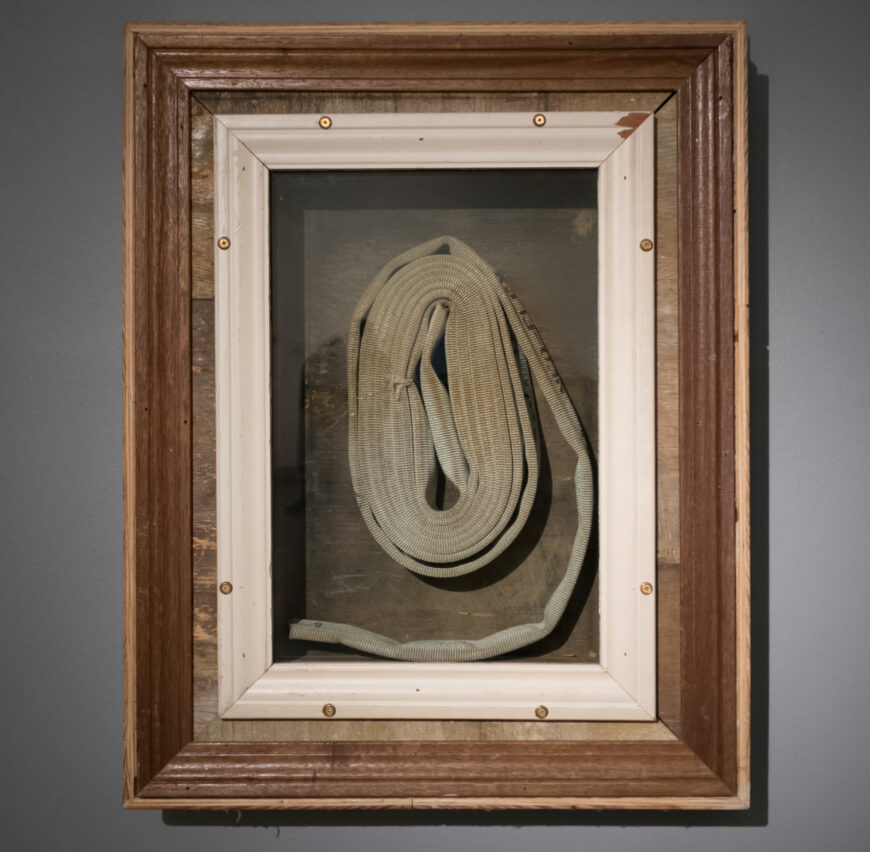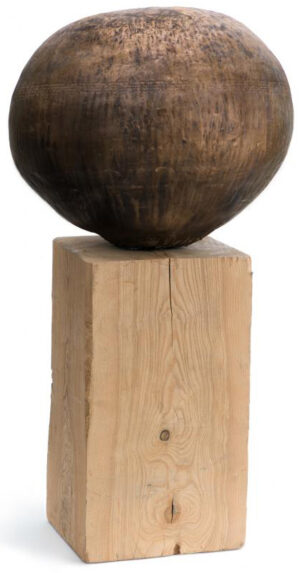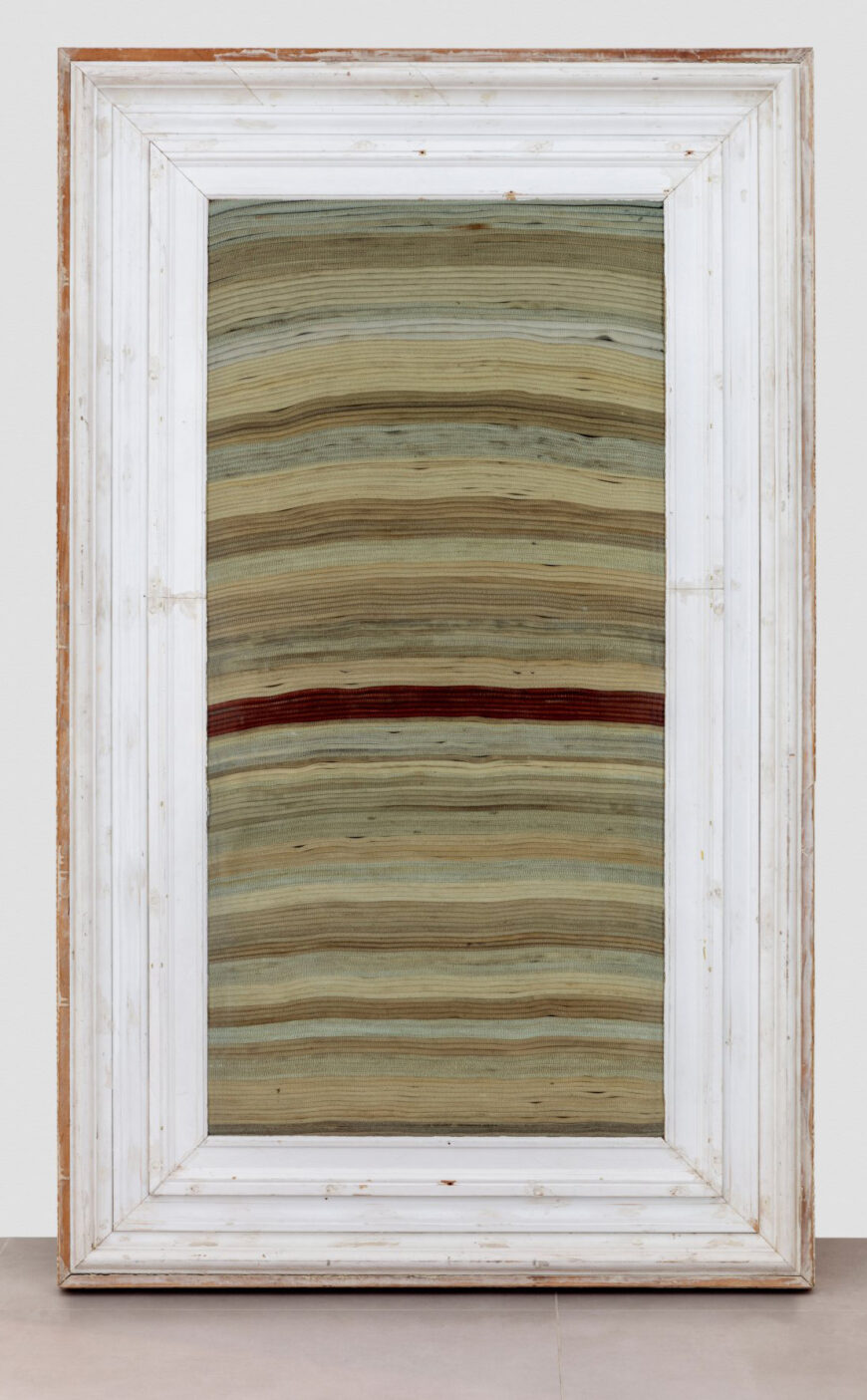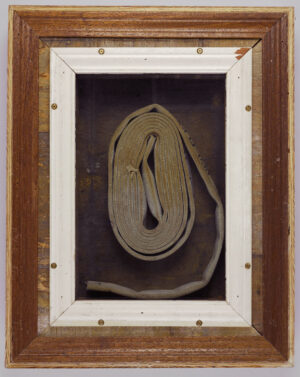
Theaster Gates, In Case of Race Riot II, 2011, wood, paint, plastic, metal, and adhesive, 85.1 x 67.6 cm (Brooklyn Museum, New York; photo: smallcurio, CC BY 2.0) © Theaster Gates
A fragment of an old firehose is coiled into an oblong shape and framed in a glass-front box. The coil of the flattened hose is tightly wound at the center but rather loose around the outer edge. Barely visible at the upper right corner is a serial number. The two extreme ends behave differently: while the slightly swollen inner end stands upright at the center of the ring, the outer end takes advantage of the looseness of the edges to separate itself, forming a casual curve at the bottom, pointing left. Several worn-out spots on its surface confirm the age of the hose.
The shadow box is doubly framed: a smaller white frame with chipped paint and visible screwheads is held by a larger one with a rough, unpainted surface. Were it not for the frame, the display in the box might be mistaken for a firehose mounted on the wall in a public building, ready for emergency use. The object is a sculpture titled In Case of Race Riot II by Theaster Gates, produced in 2011, one piece from a larger series called In the Event of a Race Riot.
Social interventions / studio production
Two aspects of Gates’ life are key to his creative work. First, born in 1973, Gates grew up in Chicago’s West Side, which has long been a crime-prone neighborhood. Second, he was trained in multiple disciplines: urban planning, fine arts, ceramics, and theology. These two experiences have converged to form two distinct yet interconnected fronts in his art practice.

Theaster Gates, Vessel #12, 2020, glazed stoneware on reclaimed ash base, 104.1 x 53.3 x 50.8 cm (LACMA) © Theaster Gates
On the one hand are Gates’ social interventions as art, such as the Dorchester Art and Housing Collaborative, which began in 2006, and the Stony Island Arts Bank, launched in 2013. Located in Chicago’s South Side, both are products of collaborations between Gates and housing authorities, city planners, architects, artists, and others. On Dorchester Avenue, Gates purchased a couple of derelict residential properties and converted them into studios, an art gallery, and low-cost housing for artists in exchange for community service. Gates’ intervention operated on a larger scale at the Stony Island Arts Bank. Here, the neo-classical building of a former bank was reshaped into a large library, an archive of Black cultural history, as well as exhibition and performance spaces. Blending art with activism, Gates’ goal in these endeavors is to create spaces for fruitful community engagement in disadvantaged neighborhoods. Rebuild Foundation, which he founded in 2010, has been invited to launch similar initiatives in other cities across the country following the successful outcomes in Chicago. On the other hand, Gates’ prolific studio production of ceramics and sculpture has brought him wide international exposure and acclaim. The community projects are often funded by the sales of the artist’s studio work.
Despite the seeming incompatibility in scale, aesthetic, and purpose of Gates’ social and studio practices, they are in fact connected. This relationship is made transparent by the principles guiding his ceramic work. The first principle is his notion of “it’s nothing until it’s something,” referring to the transformation of amorphous clay into a variety of vessels through a creative process. Closely related to this is his belief that a single potter’s vision enables an object to become part of a collective (such as when individual innovations in pottery are celebrated through communal uses of vessels). Further, as the son of a roofer, Gates sees manual labor as integral to his production of art and is committed to finding creative use of materials that would otherwise be disposed of. Not only do these beliefs inform his ceramic work, they are at the core of his community projects, and are fundamental to his sculptural enterprise. All of Gates’ sculptures are made of salvaged material. He collects discarded floorboards, door and window frames, architectural moldings, glass, and other components from condemned buildings and repurposes them into sculptures, much like his repurposing of abandoned buildings.

Theaster Gates, In The Event of a Race Riot, 2011, wood, hose, and glass, in artist’s frame, 191.8 x 116.8 cm (private collection) © Theaster Gates
Decommissioned firehoses and American history
For the series In the Event of a Race Riot, Gates acquired a large quantity of decommissioned firehoses and collected the wood and glass for the shadow boxes from buildings slated for demolition. His recycling strategy extends well beyond the issue of sustainability, as his sculptures are as rich in content as his community projects are in their embrace of the Black American experience.
While the curious assemblage of found objects that shape In Case of Race Riot II may, at first glance, appear to be an esoteric experiment that recalls the enigmatic boxes made by Joseph Cornell, it carries a specific historical reference. The hose is a reminder of the repression of civil rights activists by state authorities in Alabama in 1963, where, in addition to aggressive canine units, powerful water jets from fire hoses were routinely turned on demonstrators, often causing injuries. Like many of his other sculptures, here Gates draws on Minimalist and Conceptual art, two prominent developments in the American art scene of the 1960s and 70s. However, in opposition to Minimalism’s political disengagement, Gates guides his audience into a confrontation with this deeply troubling era of American history.
Gates borrows the Minimalist preference for industrial materials, as seen in the work of Donald Judd and Carl Andre; but unlike the minimalist penchant for impersonal and ostensibly neutral forms and surfaces, he makes use of a wide variety of recognizable industrial products that have been used before. In stark contrast to Minimalist objects, he provokes active reflection on the social lives of the objects he employs. In other words, he rejects the claim of neutrality and of the absence of the artist’s trace, both crucial to his Minimalist predecessors. Gates also distances himself from the austerity of the grid-like structures they preferred, though he partially adopts the Minimalist interest in seriality. Each of the other pieces of In the Event of a Race Riot also offers a framed firehose, which can certainly be seen serially, yet each hose is displayed differently; coiled in different ways, or tightly stacked, some of them show various tones and textures. The artist’s debt to Conceptual art is also selective: he borrows from the politically engaged Conceptual art of the 1970s and 80s for his deliberate engagement with history. In short, Gates combines signifiers of Black history with thoughtfully selected tropes of white art history to make In Case of Race Riot II meaningful.

Theaster Gates, In Case of Race Riot II, 2011, wood, paint, plastic, metal, and adhesive, 85.1 x 67.6 cm (Brooklyn Museum, New York) © Theaster Gates
The sculpture is a powerful example, as are its companion pieces in the series, of salvaged material transformed through rigorous research of interdisciplinary histories. Theaster Gates is deeply committed to the notion of cultural archives as much in his studio production of ceramics and sculpture as in his social intervention projects. In building such archives, personal narratives are no less crucial to him than collective ones because his goal is to re-present marginalized cultural memories. There is certainly a touch of humor and irony as a tool of racial oppression reappears with the aesthetic claim of Minimalist abstraction, self-consciously and redundantly framed as a work of art. Its playfulness, however, is carefully tailored to ensure that the work’s role as a device for remembering the racial strife of this chapter of American history is not overshadowed. The unadorned double frames, integral to the work, prominently frame that memory, both literally and metaphorically.




